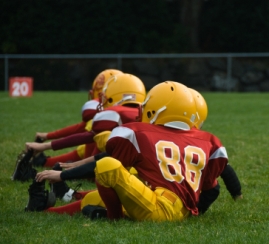INDIANAPOLIS -Robert Cantu, MD, and Chris Nowinski, co-founders of the Sports Legacy Institute (SLI), today issued a bold "Hit Count" proposal designed to dramatically reduce youth athletes' exposure to repetitive brain trauma in multiple sports, with the goal to reduce concussions, sub-concussive trauma and risk of developing Chronic Traumatic Encephalopathy (CTE).
Modeled on pitch limits in youth baseball
The "Hit Count" proposal is modeled after the "Pitch Count" system, which is promoted and enforced by Little League Baseball and other baseball organizations across the country. In the "Pitch Count" system, pitchers can only throw a predetermined number of pitches in a day based on their age (kids age 10 and under are limited to 75 pitches) and must rest a certain number of days before after pitching based on the number of pitches thrown (61+ pitches, for example, requires three days of rest). The program was developed by researchers in response to growing evidence that a small number of baseball players were "wearing out" their ulnar collateral ligament from overexposure to the trauma caused by the pitching motion.
Researchers at the Boston University Center for the Study of Traumatic Encephalopathy (BU CSTE) recently discovered the youngest documented case of CTE, a degenerative brain disease linked to trauma, in 17-year-old high school football player Nathan Stiles, which was disclosed by his family in a CNN report. More than 20 former NFL players have been found to have the same pathology, along with college football players, professional hockey players, boxers, professional wrestlers, and a soccer player, as well as non-athletes who received extraordinary brain trauma. SLI partnered with Boston University and the Veterans Administration in 2008 to found the BU CSTE. SLI plays no role in conducting the research, but rather translates the research into educational programming and policy.
"If we go to such great lengths to protect the elbows of baseball players, then heck, don't you think we ought to set limits to the number of times we allow a child to be hit in the head in sports?" said Dr. Cantu, clinical professor of neurosurgery at Boston University School of Medicine and past president of the American College of Sports Medicine (and MomsTeam.com's concussion expert emeritus). "We do not claim ownership of this idea. A Hit Count has been proposed by prominent researchers, many of whom we are grateful to for providing the research that has revealed, for example, that high school football players have been recorded taking 197 hits to the head exceeding 15g in a game and 2,235 in a season. Our goal is to translate this bold idea into policy aimed at protecting children," said Dr. Cantu. "In some sports, there is simply too much unregulated and unnecessary brain trauma."

SLI has posted a "Hit Count" White Paper [Editor's Note: this White Paper is no longer available] authored by Mr .Nowinski, who serves as SLI CEO, and Dr. Cantu, who serves as SLI Medical Advisory Board Chair, which outlines the proposal, supporting research and a timeline and strategies for implementation. SLI recognizes that many unknowns still remain, and may forever remain, regarding the danger of brain trauma in sports. However, SLI considers this a public health issue that cannot wait for perfect evidence. The big picture goal, to limit the frequency and severity of brain trauma in children, should have no opposition, SLI predicted.
"Professional and college sports organizations, including the National Football League (NFL) and the Ivy League, have taken aggressive steps to reduce sub-concussive brain trauma exposure, but those steps are not being adopted at youth levels where athletes are most at risk. The NFL and NFL Players Association have agreed to a limit of 14 full-contact practices during the season, less than one per week, primarily to limit exposure to brain trauma, and yet we are aware of youth programs practicing in full pads four days a week," said Nowinski, a former All Ivy Harvard football player, WWE professional wrestler and author of Head Games: Football's Concussion Crisis.
"The toughest men in the world, NFL players, have asked to be hit in the head fewer times because they recognize there is no such thing as a tough brain. Children, who cannot provide informed consent, have never been asked that question, but I believe their answer would be the same," added Nowinski.
Adoption by 2013 is goal
Football, soccer, and rugby are the primary sports where athletes regularly receive sub-concussive brain trauma over 1,000 times in a season. SLI plans to convene a series of meetings with medical experts, youth sports organizations, industry, and others, with the goal to have Hit Counts adopted by youth sports organizations by 2013. [January 12, 2015 update: No Hit Counts have been established, much less adopted by any sports organization]
Dr. Cantu noted, "If we don't take action, we will live in the safest country in the world for a young boy to have an elbow, and the most dangerous country for him to have a brain." The policy, if adopted, could reduce cumulative lifetime brain trauma by over 50% for many athletes.
Source: Sports Legacy Institute
Posted February 3, 2012; most recently updated January 12, 2015








